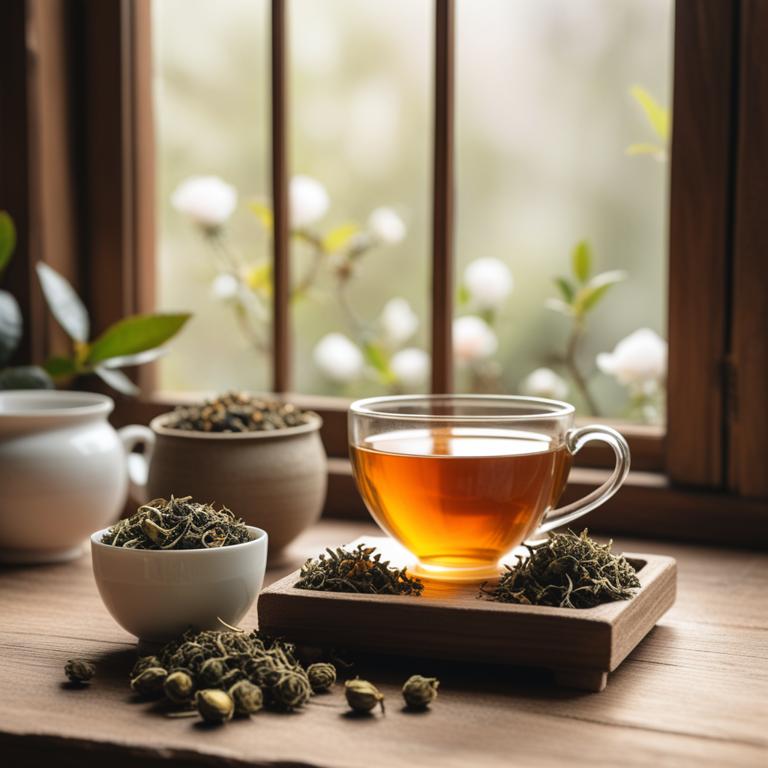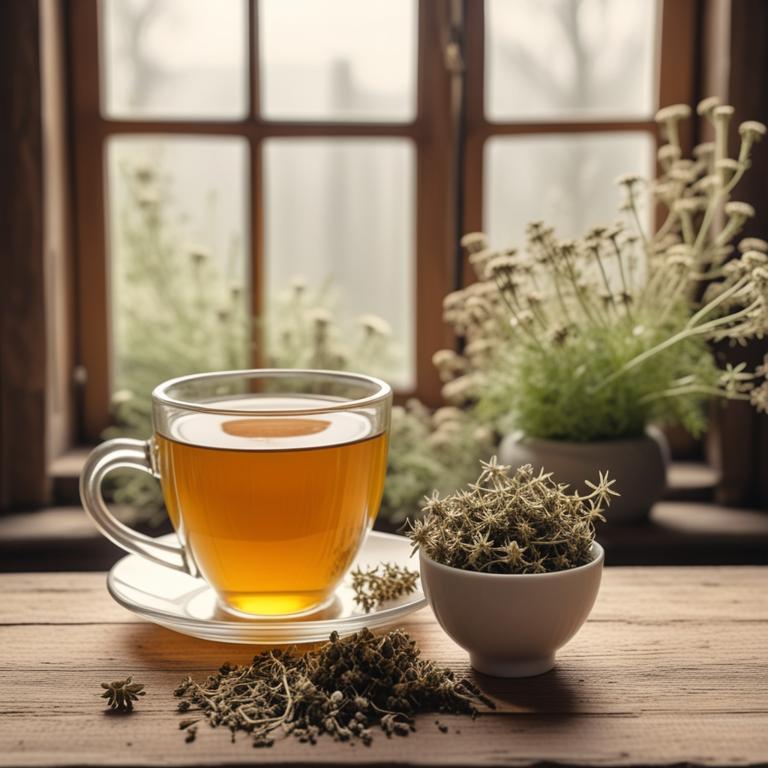8 Herbal Teas For Eye Bags

Herbal teas have been used for centuries to help reduce the appearance of eye bags, and it's not hard to see why.
When we're stressed or tired, our bodies hold onto water, causing our eyes to puff up. Herbal teas like Rosmarinus officinalis, or rosemary, can help with this. Rosemary has natural anti-inflammatory properties that can reduce swelling and promote blood flow, which helps to get rid of excess water under the eyes. Another herb that can help with eye bags is Echinacea purpurea, also known as coneflower. This herb is known for its immune-boosting properties, which can help fight off infections and reduce puffiness.
When our immune system is strong, our body is less likely to retain water, making eye bags less noticeable. Some herbal teas also contain antioxidants, like Zingiber officinale, or ginger, which can help protect the skin from damage and promote healthy skin cells. Drinking herbal teas can also have other benefits for your life. Not only can they help you look more rested and refreshed, but they can also improve your mood and energy levels. Many herbal teas have a calming effect, which can help reduce stress and promote better sleep. This can be especially helpful if you're prone to eye bags, as it can help you get to the root of the problem rather than just treating the symptoms.
By incorporating herbal teas into your daily routine, you can look and feel better, and that's something to get excited about.
- 1. Rosmarinus officinalis
- 2. Echinacea purpurea
- 3. Zingiber officinale
- 4. Ginkgo biloba
- 5. Lavandula angustifolia
- 6. Camellia sinensis
- 7. Valeriana officinalis
- 8. Melissa officinalis
1. Rosmarinus officinalis

Rosmarinus officinalis teas contains rosmarinic acid, a powerful antioxidant that helps reduce puffiness and inflammation around the eyes.
This compound also has anti-inflammatory properties that soothe and calm the skin, reducing the appearance of eye bags. The tea's high levels of camphor and borneol can also help to improve circulation and reduce fluid retention, which can contribute to eye bags. Additionally, rosmarinic acid's ability to neutralize free radicals helps protect the delicate skin around the eyes from environmental stressors and oxidative damage.
By drinking Rosmarinus officinalis tea, you may experience a reduction in the appearance of eye bags and a more refreshed, revitalized appearance.
- Gather 2 tablespoons of dried Rosemary leaves (Rosmarinus officinalis).
- Steep the Rosemary leaves in 1 cup of boiling water for 5-7 minutes.
- Strain the liquid into a cup and discard the solids.
- Let the tea cool down to room temperature.
- Soak a cotton pad or a clean cloth in the cooled tea and place it over the eye bags for 10-15 minutes.
2. Echinacea purpurea

Echinacea purpurea teas contains a number of bioactive constituents, including alkylamides, glycoproteins, and phenolic acids.
These compounds have anti-inflammatory properties, which help to reduce puffiness and swelling under the eyes. The glycoproteins, in particular, are known to inhibit the production of bradykinin, a peptide that causes blood vessels to dilate and lead to increased fluid accumulation. By reducing bradykinin production, Echinacea purpurea teas helps to minimize the appearance of eye bags and dark circles.
The phenolic acids also have antioxidant properties, which help to protect the delicate skin under the eyes from damage and promote a more even skin tone.
- Gather 2 teaspoons of dried Echinacea purpurea flowers and 1 cup of boiling water.
- Steep the flowers in the boiling water for 5-7 minutes.
- Strain the mixture into a cup using a tea strainer.
- Let the tea cool down to a warm temperature, then apply it to the eye bags using a cotton ball or pad.
- Leave the tea on the eye bags for 5-10 minutes before rinsing with cold water and patting dry.
3. Zingiber officinale

Zingiber officinale teas contains a compound called gingerol, which has anti-inflammatory properties that help reduce puffiness around the eyes.
The flavonoids and phenolic acids in gingerol also work to improve circulation and reduce fluid retention in the body, making it easier for the eyes to look less swollen. Additionally, the antioxidant properties of gingerol help protect the delicate skin around the eyes from damage caused by free radicals. Gingerol also has a vasoconstrictor effect, which means it helps to narrow the blood vessels and reduce the amount of blood that flows to the area, further reducing puffiness.
Drinking Zingiber officinale teas regularly may help to alleviate the appearance of eye bags due to its anti-inflammatory and antioxidant properties.
- Gather 1 tablespoon of dried Zingiber officinale root and 1 cup of boiling water.
- Steep the Zingiber officinale root in the boiling water for 5-7 minutes.
- Strain the liquid and discard the root.
- Let the tea cool down to room temperature.
- Soak a cotton pad or a clean cloth in the cooled tea and apply it to the affected area for 10-15 minutes.
Zingiber Officinale Tea on Amazon
FGO Organic Ginger Tea, 100 Count, Eco-Conscious Tea Bags, Caffeine Free, Packaging May Vary (Pack of 1)
Disclaimer: We earn a commission if you click this link and make a purchase at no additional cost to you.
4. Ginkgo biloba

Ginkgo biloba teas contains flavonoids and terpenoids as its bioactive constituents.
These compounds have anti-inflammatory properties that help reduce puffiness around the eyes. The flavonoids, particularly quercetin and kaempferol, also have antioxidant properties that protect the delicate skin around the eyes from damage. The terpenoids, such as bilobalide, have been shown to improve circulation and reduce swelling, making them effective in alleviating eye bags.
By reducing inflammation and improving circulation, Ginkgo biloba teas can help minimize the appearance of eye bags.
- Gather 1 cup of boiling water and 1 teaspoon of dried Ginkgo biloba leaves.
- Steep the Ginkgo biloba leaves in the boiling water for 5-7 minutes.
- Strain the tea into a cup using a fine-mesh sieve or cheesecloth.
- Add 1 tablespoon of honey to the tea, if desired, to sweeten it.
- Drink the tea slowly and warm, ideally before bedtime to help reduce eye bags.
5. Lavandula angustifolia

Lavandula angustifolia teas contains linalool, linalyl acetate, and lavandulol as its main bioactive constituents.
These compounds have anti-inflammatory and antioxidant properties that can help reduce puffiness and dark circles around the eyes. The antioxidants in Lavandula angustifolia teas can also improve circulation and reduce fluid retention, which can contribute to eye bags. By reducing inflammation and improving circulation, Lavandula angustifolia teas can help give the appearance of smoother, more rested eyes.
The soothing and calming effects of Lavandula angustifolia teas can also help reduce stress, which is a common contributor to eye bags.
- Gather 1 cup of dried Lavandula angustifolia flowers.
- Measure 2 tablespoons of dried flowers and place them in a teapot.
- Add 1 cup of boiling water to the teapot.
- Let the mixture steep for 5-7 minutes, then strain it.
- Soak a cotton pad or a clean cloth in the tea, and apply it to the eye bags for 10-15 minutes.
6. Camellia sinensis

Camellia sinensis teas contains antioxidants like theaflavins and thearubigins, which help reduce inflammation in the skin around the eyes.
These compounds also have anti-aging properties that can help reduce the appearance of dark circles and puffiness. Catechins in Camellia sinensis teas are a type of flavonoid that can improve circulation, which may help reduce the appearance of eye bags by reducing fluid retention. Additionally, Camellia sinensis teas contains L-theanine, an amino acid that can help relax the body and mind, reducing stress and fatigue that can contribute to eye bags.
Drinking Camellia sinensis teas regularly may help reduce the appearance of eye bags due to its antioxidant and anti-inflammatory properties.
- Gather Camellia sinensis (black, green, or white tea) leaves and 1 cup of boiling water.
- Measure 1-2 teaspoons of tea leaves into a tea infuser or a small cup.
- Pour 1 cup of boiling water over the tea leaves and let it steep for 3-5 minutes.
- Strain the tea and let it cool down to room temperature.
- Soak a clean cloth in the cooled tea and apply it to the eye bags for 5-10 minutes.
7. Valeriana officinalis

Valeriana officinalis teas contains valerenic acid, valepotriates, and isovaleramide as its active constituents.
These compounds have a sedative effect on the body, which can help reduce puffiness and dark circles under the eyes. The anti-inflammatory and antioxidant properties of valerenic acid and valepotriates can also help soothe and calm the skin around the eyes. By reducing inflammation and promoting relaxation, Valeriana officinalis teas may help to alleviate the appearance of eye bags.
The calming effect of isovaleramide can also contribute to a more rested and refreshed appearance of the eyes.
- Gather 1 cup of boiling water, 1 tablespoon of dried Valeriana officinalis roots, and a tea infuser or strainer.
- Place the dried roots in the tea infuser or strainer.
- Pour the boiling water over the roots and let it steep for 5-7 minutes.
- Strain the tea into a cup and discard the solids.
- Let the tea cool down, then use it as a compress to reduce eye bags by soaking a cloth in the tea and applying it to your eyes for 10-15 minutes.
8. Melissa officinalis

Melissa officinalis teas contains rosmarinic acid, apigenin, and luteolin as its key bioactive constituents.
These compounds have anti-inflammatory and antioxidant properties, which help to reduce puffiness and swelling around the eyes. The antioxidant properties of rosmarinic acid and luteolin also help to neutralize free radicals that can cause damage to the delicate skin around the eyes. Apigenin has a calming effect on the body, which can help to reduce stress and promote better sleep, both of which can contribute to the appearance of eye bags.
By reducing inflammation and promoting better sleep, Melissa officinalis teas may help to alleviate the appearance of eye bags.
- Gather 1 cup of fresh Melissa officinalis leaves and flowers.
- Heat 1 cup of water in a pot until it starts boiling.
- Add 1 tablespoon of honey to the boiling water and remove from heat.
- Add the gathered Melissa officinalis leaves and flowers to the honey-infused water and let it steep for 5-7 minutes.
- Strain the tea and let it cool down before applying it to the eye bags using a cotton pad.